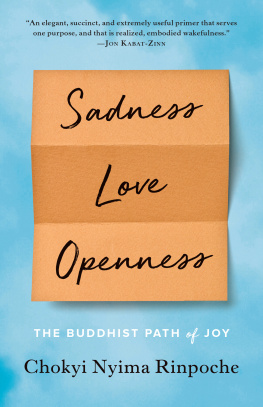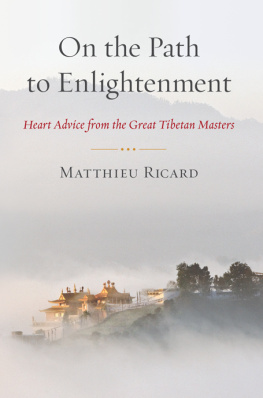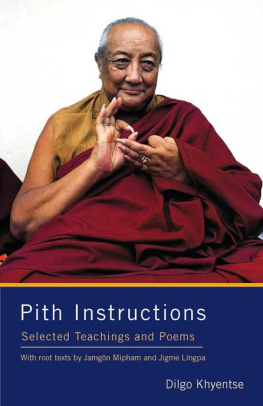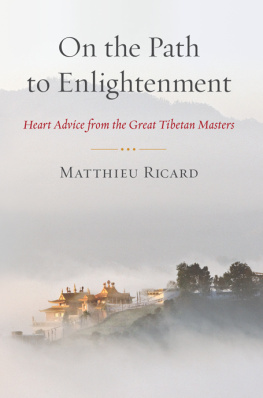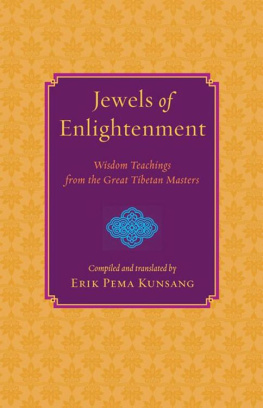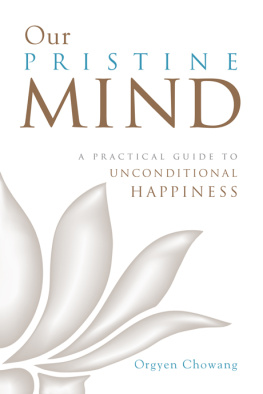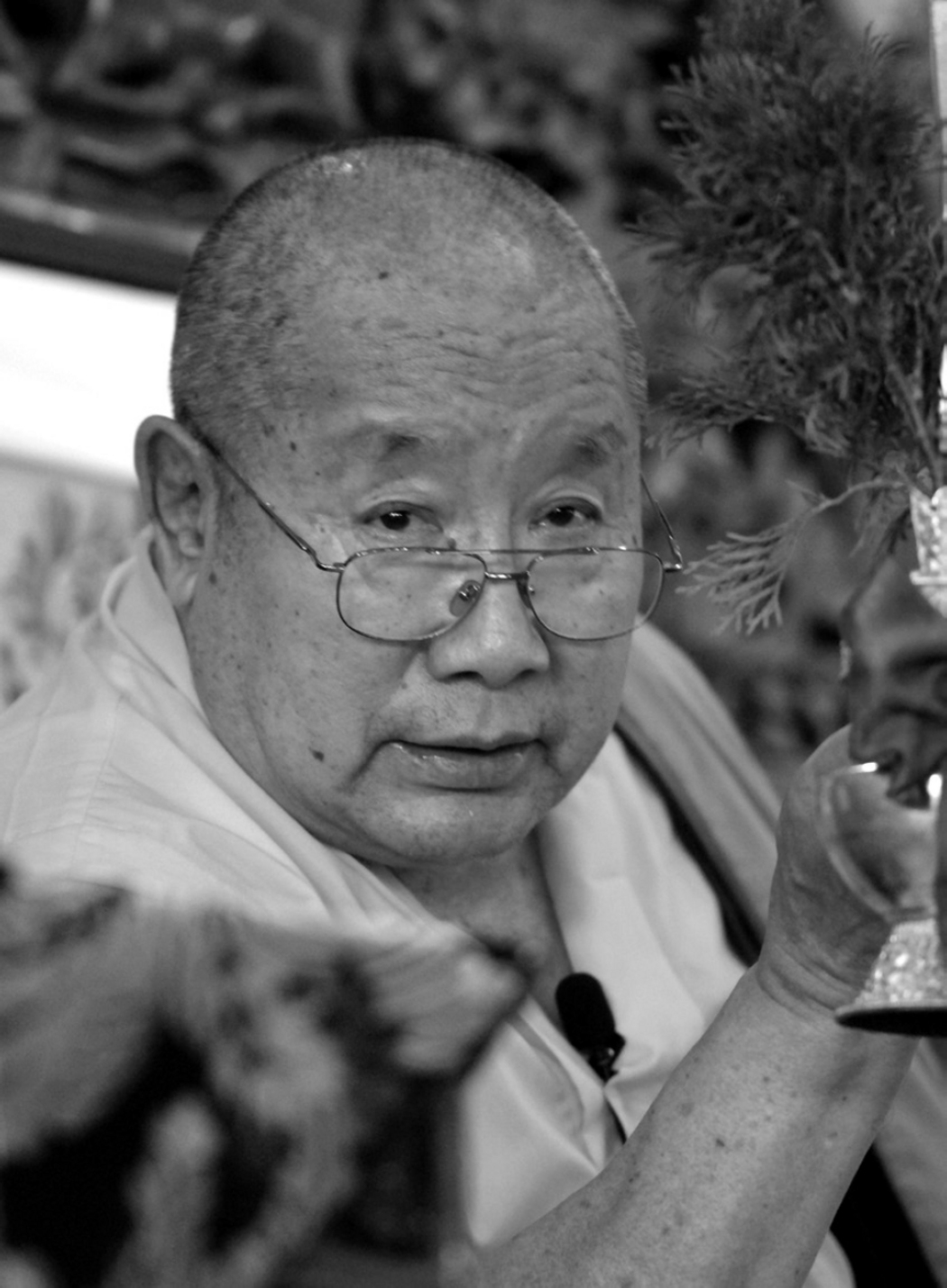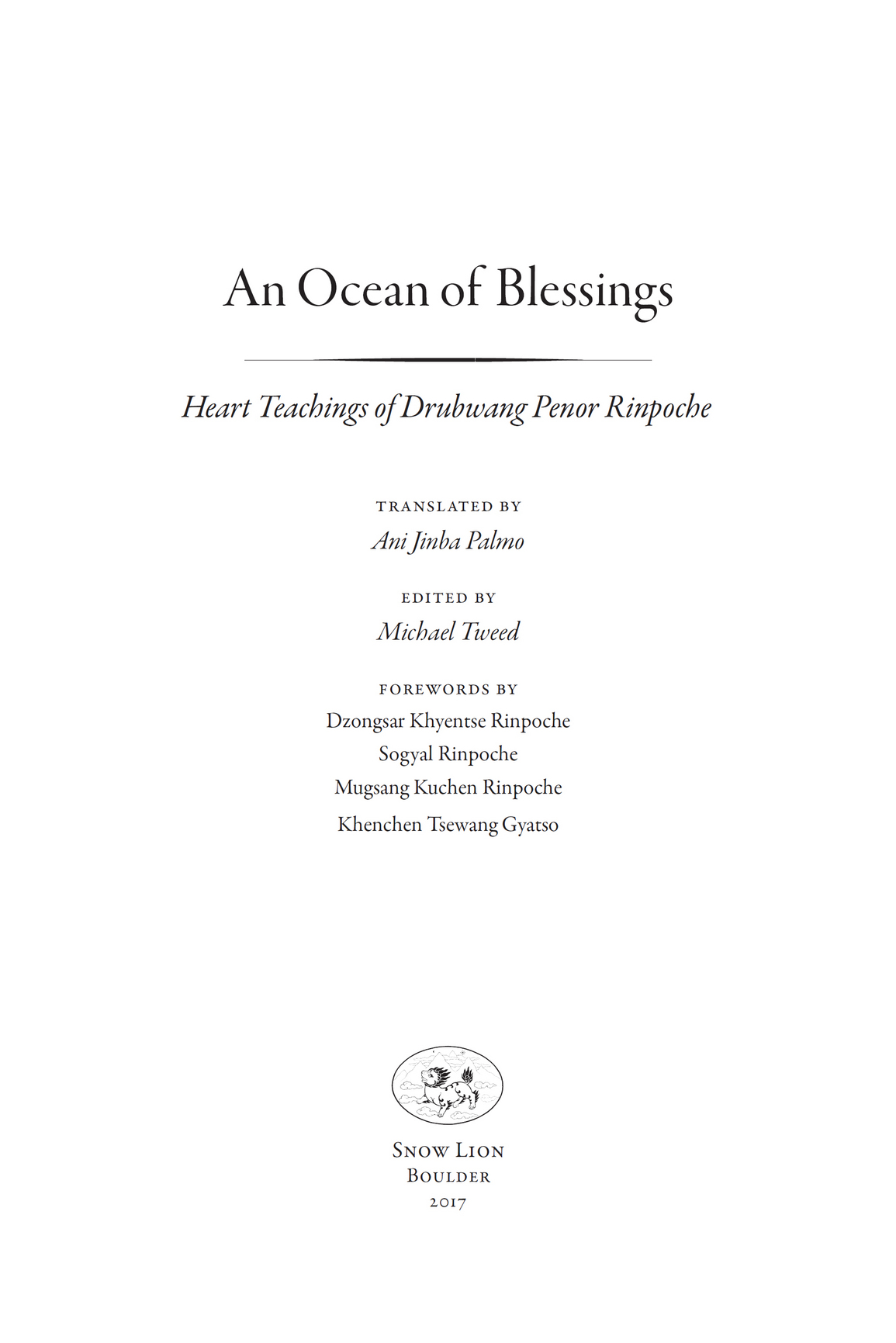An imprint of Shambhala Publications, Inc.
Palyul Retreat Center, upstate New York (Photo 2006 by Mannie Garcia).
All rights reserved. No part of this book may be reproduced in any form or by any means, electronic or mechanical, including photocopying, recording, or by any information storage and retrieval system, without permission in writing from the publisher.
Names: Penor Rinpoche III, 19322009, author. | Tweed, Michael, editor.
Title: An ocean of blessings: heart teachings of Drubwang Penor Rinpoche / Penor Rinpoche; translated by Ani Jinba; edited by Michael Tweed.
Description: First edition. | Boulder: Snow Lion, 2017. | Translated from Tibetan.
Subjects: LCSH: Penor Rinpoche III, 19322009Teachings. | Buddhism.
F OREWORD
D ZONGSAR K HYENTSE R INPOCHE
T HE T IBETAN WORD jin-lap is loosely translated as blessings. Jin-lap transforms our whole beingour body, our speech, the way we think, how we understand phenomena, and the way we relate to ourselves and the world. Ultimately, however, what jin-lap does is to break the shell of our ego and force us to see the true nature of our minds.
Among many other causes and conditions, in the Vajrayana it is the guru who is considered the most important and indeed supreme cause for doing all the above. In fact, that force and power is all the stronger if the guru is a realized being, if he is genuinely compassionate, and if he considers helping sentient beings the main purpose of his existence.
Kyabje Penor Rinpoche is one such great master of our time, as unanimously confirmed time and again by some of the most illustrious masters of the past hundred years, including Kyabje Dudjom Rinpoche, Kyabje Dilgo Khyentse Rinpoche, and Khenpo Jigme Phuntsok. I dont have to detail Penor Rinpoches perseverance and dedication in tirelessly propagating the Dharma to benefit sentient beings. That is all there to be seen in his actions and in his continuing legacy.
Here is a very precious collection of Kyabje Penor Rinpoches teachings. I have no doubt that these teachings, if not a blessing in themselves, will be a bridge to receive jin-lap from the master himself. Ani Jinba Palmos long association with and marination in the Buddhadharma have certainly helped her to closely translate and interpret the words of this great master. These teachings should not be kept on a bookshelf but read, and not only read but put into practice.
Bodhgaya, November 2016
F OREWORD
S OGYAL R INPOCHE
I T IS A great blessing and honor to be invited to introduce this anthology of teachings by His Holiness Penor Rinpoche, who was not only one of the most important Tibetan Buddhist masters of the twentieth century, but also a visionary and a leader who played a vital and timely role in keeping alive the profound teachings and practices of the Buddhist tradition of Tibet.
Looking back now, we all remember only too readily how the twentieth century witnessed a long period of turmoil, misery, and upheaval in Tibet. It was a time when the sheer survival of the Tibetan people and their unique Buddhist culture seemed in doubt. I will never forget how in the spring of 1959 I was in Sikkim, a Himalayan kingdom and one of the hidden lands of Guru Padmasambhava, alongside my master Jamyang Khyentse Chkyi Lodr, whose health was gradually failing. Later, when summer came, he passed away. During those few months of mounting uncertainty, pieces of bleak and terrible news about the tragic events in Tibet trickled through, day by day. At the same time, thousands upon thousands of ordinary Tibetan men, women, and children, as well as monks, nuns, and lamas, were making the long and dangerous journey from their homeland across the Himalayas into exile. Among them were a number of great Buddhist masters, and one of them was Kyabje Penor Rinpoche.
Years later, we would all hear of how Penor Rinpoche, the head of the great monastery of Palyul in eastern Tibetone of the six mother monasteries in the Ngagyur Nyingma traditionhad eventually found himself in Mysore in southern India with a few monks and a mere 300 rupees to his name. Yet with his incredible vision, ingenuity, and determination, and by throwing himself into hard manual labordigging, building, driving, as well as buying and fetching supplieshe had gradually brought into existence what was to become one of the largest Tibetan monasteries in exile. The Namdroling monastery complex he founded is now home to thousands of monks and nuns. Penor Rinpoche is someone who will go down in history as one of the prime architects in the spread of Tibetan Buddhism, and especially of the Ngagyur Nyingma tradition.
Penor Rinpoche was universally respected on account of the meticulous care he tookwhether it was in passing on all the most important empowerments and transmissions; preserving the authenticity of the tradition along with its rare texts; training the Palyul lineage holders and lamas, for example, the three heart sons Karma Kuchen Rinpoche, Khentrul Gyangkhang Rinpoche, and Mugsang Kuchen Rinpoche; or ordaining countless monks and nuns. Again and again, he would invite the great Tibetan masters to pass on teachings to the young tulkus and lamas. Kyabje Dilgo Khyentse Rinpoche, for example, whom Penor Rinpoche saw as Vajradhara, the primordial buddha in person, visited Namdroling on numerous occasions and granted many transmissions.
Overcoming enormous difficulties and against all odds, Penor Rinpoche succeeded in bringing together outstanding scholars from all traditionsI think of Khenpo Rinchen from the Sakya tradition, for exampleto establish a shedra, or college of advanced Buddhist studies, that has set new standards of excellence in scholarship for the Ngagyur Nyingma tradition. This was a truly historic achievement, for today Namdroling is famous for its world-class Ngagyur Nyingma University, which is led by outstanding authorities such as Khenchen Pema Sherab, Khenchen Namdrol, and Khenchen Tsewang Gyatso, and has sent khenpos and teachers to Nyingma monasteries and Dharma communities in many parts of the world, especially to the Himalayan regions like Bhutan and Nepal. To sum up, Penor Rinpoche was truly what you might call a hands-on lama who, during a very challenging time for Tibetan people, single-handedly pieced together the entire community around Namdroling. He not only cared for the monks and nuns, but equally for the lay community by founding schools and hospitals, which were all part of the scope of his vast compassionate vision.



